Notes: Llangybi was situated on the Menai Bridge – Afon Wen line which opened in stages between 1852 and 1871. On 29 July 1862 the Carnarvonshire Railway (CR) was authorised to build a line between Caernarfon and Afon Wen and by October 1866 it was mostly complete and was inspected, but its opening was not approved until 2 September 1867 by which time all work was finished.
 |
Llangybi was in an isolated location and did not open with the line. There was a level crossing at the location, and from March 1869 trains picked up passengers for fairs and markets only. It is unlikely that there were any facilities at Llangybi at this time. On 4 July 1870 the CR had become part of the London & North Western Railway (LNWR). From October 1870 Llangybi was shown in the Bradshaw timetable as having trains on Tuesdays only; by January 1872 it had services every day. A single-storey stone building and a platform were provided on the north side of the level crossing, west of the line. The building had a booking and parcels office. The platform was to the north of the building and had a timber face backfilled with cinders. The station was also provided with a siding on the west side of the line, north of the station. Accommodation in the form of two cottages was provided for staff on the east side of the line.
Passenger services ran |
between Bangor and Afon Wen with some trains continuing beyond Afon Wen. By December 1895 Llangybi had five up and five down trains on weekdays with an extra train in each direction on Mondays. There was also one train in each direction on Sundays.
In 1915 a passing loop was installed at Llangybi and an extra platform was provided; the new line was located to the east of the original. The original line and platform became the ‘up’ direction (Menai Bridge) and the new the ‘down’ (Afon Wen). A timber waiting shelter, which contained a ladies’ waiting room, was provided on the up platform. A barrow crossing at the south end of the station connected the platforms. The down home signal was on the down platform, north of the crossing, to protect it while passengers were using it.
| South of the original station building, on the west side of the line, was the small timber signal box which controlled the passing loop at Llangybi. It was a standard LNWR box with a 15-lever frame, but it measured only 12 x 12ft and stood only 8ft 6in above the ground. The token exchange equipment was installed in the original station building. |
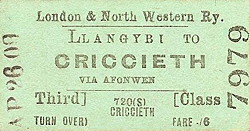 |
By July 1922 there were seven up and five down trains Monday-to-Saturday as seen in the table below. There were no Sunday trains.
| Up Trains (Menai Bridge direction) July 1922 |
Destination |
Down Trains (Afon Wen direction) July 1922 |
Destination |
| 7.09am |
Bangor |
10.03am |
Afon Wen |
| 9.44am |
Bangor |
12.40pm |
Afon Wen |
| 11.10am |
Bangor |
1.31pm |
Afon Wen |
| 4.14pm |
Bangor |
6.11pm |
Afon Wen |
| 5.44pm |
Bangor |
8.22pm |
Afon Wen |
| 7.09pm |
Bangor |
|
|
| 9.11pm |
Carnarvon |
|
|
On 1 January 1923 Llangybi became part of the London Midland & Scottish Railway (LMS). By 1928 they were running nine up and seven down trains. The service was the same in the summer of 1932. In 1938 the siding at Llangybi was taken out of use and lifted.
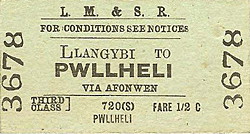 |
With the outbreak of the Second World War an emergency timetable was introduced from 11 September 1939, and Llangybi had only three trains in each direction on Monday-to-Saturday. The service was improved from 1 January 1940 when six trains ran in each direction on Monday-to-Saturday. During the winter of 1946/47 the passing loop at Llangybi was |
extended, and the platforms were rebuilt with prefabricated concrete sections.
On 1 January 1948 Llangybi became part of the British Railways London Midland Region. The summer 1948 timetable showed seven up and seven down trains Monday-to-Saturday as shown in the table below.
| Up Trains (Menai Bridge direction) Summer 1948 |
Destination |
Down Trains (Afon Wen direction) Summer 1948 |
Destination |
| 8.19am (Saturdays Excepted) |
Bangor |
7.08am |
Afon Wen |
| 8.22am (Saturdays Only ) |
Llandudno Junction |
10.10am |
Afon Wen |
| 10.56am (Saturdays Only ) |
Liverpool Lime Street |
1.29pm |
Afon Wen |
| 11.06am (Saturdays Excepted) |
Bangor |
4.05pm (Saturdays Excepted) |
Afon Wen |
| 4.04pm (Saturdays Excepted) |
Bangor |
4.31pm (Saturdays Only ) |
Afon Wen |
| 4.10pm (Saturdays Only ) |
Bangor |
5.23pm (Saturdays Excepted) |
Afon Wen |
| 5.22pm |
Bangor |
5.55pm (Saturdays Only ) |
Afon Wen |
| 7.17pm |
Bangor |
6.44pm (Saturdays Excepted) |
Afon Wen |
| 8.51pm |
Bangor |
6.50pm (Saturdays Only ) |
Afon Wen |
| 10.01pm |
Bangor |
9.15pm |
Afon Wen |
In 1939 Billy Butlin built a holiday camp at Penychain on the former Cambrian line to the west of Afon Wen. Due to the war it did not open for holidaymakers until the summer season of 1947 although it was used during the war by the Royal Navy. The opening of the holiday camp brought a lot of extra traffic in the form of holiday specials to the Menai Bridge – Afon Wen line during the summer months, and the specials were much longer than routine service trains.
By the mid 1950s the line through Llangybi was very busy during the summer months especially on Saturdays when a number of extra services ran to and from Penychain. Most of the trains passed through Llangybi the summer timetable for 1960 showed only eight up and six down trains called to pick up passengers on Monday-to-Saturday as seen in the table below.
| Up Trains (Menai Bridge direction) Summer 1960 |
Destination |
Down Trains (Afon Wen direction) Summer 1960 |
Destination |
| 8.14am (Saturdays Excepted) |
Bangor |
10.11am |
Afon Wen |
| 8.22am (Saturdays Only ) |
Manchester Exchange |
12.39pm |
Afon Wen |
| 10.56am (Saturdays Only ) |
Liverpool Lime Street |
1.23pm (Saturdays Excepted) |
Pwllheli |
| 11.01am (Saturdays Excepted) |
Bangor |
1.52pm (Saturdays Only ) |
Pwllheli |
| 2.22pm |
Bangor |
4.01pm (Saturdays Excepted) |
Pwllheli |
| 4.02pm (Saturdays Excepted) |
Llandudno |
4.26pm (Saturdays Only ) |
Afon Wen |
| 4.04pm (Saturdays Only ) |
Bangor |
6.51pm (Saturdays Excepted) |
Pwllheli |
| 5.40pm |
Bangor |
6.53pm (Saturdays Only ) |
Afon Wen |
| 7.15pm |
Bangor |
8.15pm (Saturdays Excepted) |
Afon Wen |
| 8.16pm (Saturdays Excepted) |
Bangor |
8.24pm (Saturdays Only ) |
Afon Wen |
| 8.25pm (Saturdays Only ) |
Bangor |
|
|
| 8.45pm (Saturdays Excepted) |
Bangor |
|
|
| 8.55pm (Saturdays Only ) |
Bangor |
|
|
DMUs were introduced onto many services from 1958. The line remained busy in the summer months into the 1960s but during the winter period it was very quiet. The Reshaping of British Railways report of 1963 (The ‘Beeching’ Report) recommended that the line between Caernarfon and Afon Wen be closed completely. This was despite the still very heavy holiday traffic in the summer. Interestingly in 1964 steam-hauled trains were used on most services with DMUs being sent elsewhere. The line between Caernarfon and Afon Wen closed completely on 7 December 1964.
The line through Llangybi was not lifted immediately, and track was still in situ in 1968. The station platforms survived in a derelict condition until the early 1980s. In May 2012 the original station building was extant and used as a private dwelling, as were the railway cottages.
Tickets from Michael Stewart route map drawn by Alan Young
Sources:
To see the other stations on the Menai Bridge - Afonwen line click on the station name: Menai Bridge, Treborth, Port Dinorwic (1st), Port Dinorwic (2nd), Griffiths Crossing, Caernarvon, Carnarvon Pant, Dinas, Llanwnda, Groeslon, Penygroes, Pant Glas, Brynkir, Ynys, Chwilog & Afonwen |

old3.jpg)
.jpg)
.jpg)
old4.jpg)
old2.jpg)
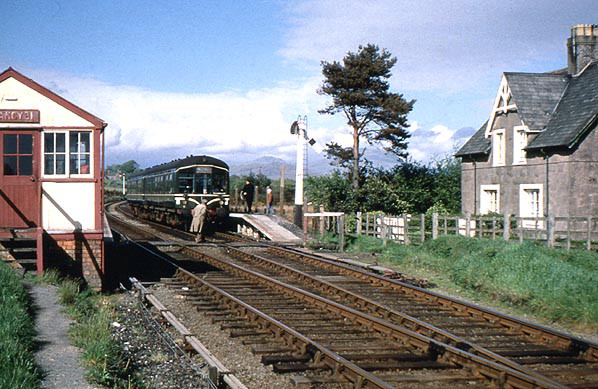
old5.jpg)
old6.jpg)
old1.jpg)
6.jpg)
9.jpg)
1.jpg)



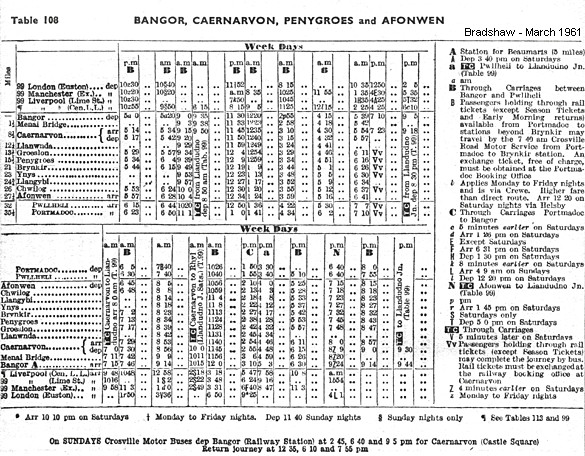
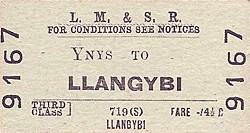
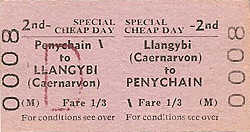
3.jpg)
4.jpg)
5.jpg)
7.jpg)
8.jpg)
2.jpg)
2.jpg)


 Home Page
Home Page